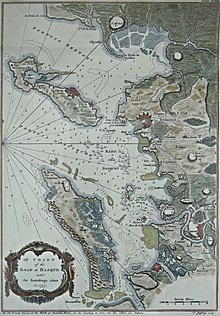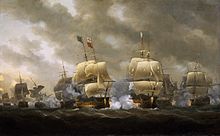
Admiral of the Fleet Richard Howe, 1st Earl Howe, was a British naval officer. After serving throughout the War of the Austrian Succession, he gained a reputation for his role in amphibious operations against the French coast as part of Britain's policy of naval descents during the Seven Years' War. He also took part, as a naval captain, in the decisive British naval victory at the Battle of Quiberon Bay in November 1759.

Edward Hawke, 1st Baron Hawke, KB, PC, of Scarthingwell Hall in the parish of Towton, near Tadcaster, Yorkshire, was a Royal Navy officer. As captain of the third-rate HMS Berwick, he took part in the Battle of Toulon in February 1744 during the War of the Austrian Succession. He also captured six ships of a French squadron in the Bay of Biscay in the Second Battle of Cape Finisterre in October 1747.
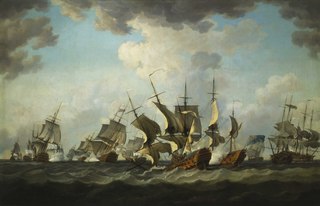
The Battle of Quiberon Bay was a decisive naval engagement during the Seven Years' War. It was fought on 20 November 1759 between the Royal Navy and the French Navy in Quiberon Bay, off the coast of France near St. Nazaire. The battle was the culmination of British efforts to eliminate French naval superiority, which could have given the French the ability to carry out their planned invasion of Great Britain. A British fleet of 24 ships of the line under Sir Edward Hawke tracked down and engaged a French fleet of 21 ships of the line under Marshal de Conflans. After hard fighting, the British fleet sank or ran aground six French ships, captured one and scattered the rest, giving the Royal Navy one of its greatest victories, and ending the threat of French invasion for good.

HMS Royal George was a ship of the line of the Royal Navy. A first-rate with 100 guns on three decks, she was the largest warship in the world at the time of her launch on 18 February 1756. Construction at Woolwich Dockyard had taken ten years.

Robert Duff was an officer of the Royal Navy during the War of the Austrian Succession, the Seven Years' War and the American War of Independence. He rose to the rank of Admiral, and served briefly as colonial governor of Newfoundland.

Vice-Admiral Sir Joshua Rowley, 1st Baronet (1734–1790) was the fourth son of Admiral Sir William Rowley. Sir Joshua was from an ancient English family, originating in Staffordshire (England) and was born on 1 May 1734. Rowley served with distinction in a number of battles throughout his career and was highly praised by his contemporaries. Unfortunately whilst his career was often active he did not have the opportunity to command any significant engagements and always followed rather than led. His achievements have therefore been eclipsed by his contemporaries such as Keppel, Hawke, Howe and Rodney. Rowley however remains one of the stalwart commanders of the wooden walls that kept Britain safe for so long.

HMS Prince was a 100-gun first rate ship of the line of the Royal Navy, built by Phineas Pett the Younger at Deptford Dockyard and launched in 1670.
Hubert de Brienne, Comte de Conflans was a French naval commander.

HMS Essex was a 70-gun third rate built by Sir Henry Johnson of Blackwall in 1678/79. During the War of the English Succession she fought in the last major action. She was rebuilt in 1699/1700. During the War of Spanish Succession she fought at Vigo Bay, the Capture of Gibraltar and Velez Malaga. She also fought at the Battle off Passero in 1718. She was rebuilt again in 1736-40. She was in action off Toulon in 1744. She was active in the Channel and against French ports during the Seven Years War. She fought at Quiberon Bay in 1759. She was wrecked in Quiberon Bay in November 1759.

HMS Expedition was a 70-gun third-rate ship of the line built at Portsmouth Dockyard in 1677/79. She was in active commission during the War of the English Succession participating in the battles of Beachy Head and Barfleur. She was rebuilt in 1699. Again, for the War of Spanish Succession she was in commission for the operation at Cadiz then returned to England where she sat for two years. She was in the Mediterranean for the Battle of Marbella in 1705. She then went to the West Indies and fought in Wager’s action off Cartagena in 1708. She was rebuilt in 1709-14 to the 1706 Establishment. She spent her time split between the Baltic and as guard ship at Portsmouth before being broken at Portsmouth in 1736. She was rebuilt in 1736/40 at Deptford Dockyard.

HMS Swiftsure was a 70-gun third-rate ship of the line of the Royal Navy, launched in 1755 and in active service during the Seven Years' War. After a distinguished career at sea she was decommissioned in 1763 and sold into private hands ten years later.
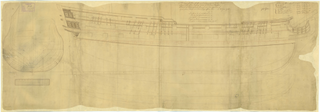
HMS Orford was a 70-gun third rate ship of the line of the Royal Navy, built to the draught specified by the 1745 Establishment at Woolwich Dockyard, and launched in 1749.

The Raid on Rochefort was a British amphibious attempt to capture the French Atlantic port of Rochefort in September 1757 during the Seven Years' War. The raid pioneered a new tactic of "descents" on the French coast, championed by William Pitt who had taken office a few months earlier.

Allemand's expedition of 1805, often referred to as the Escadre invisible in French sources, was an important French naval expedition during the Napoleonic Wars, which formed a major diversion to the ongoing Trafalgar Campaign in the Atlantic Ocean. With the French Mediterranean Fleet at sea, Emperor Napoleon I hoped to unite it with the French Atlantic Fleet and together form a force powerful enough to temporarily displace the British Royal Navy Channel Fleet for long enough to allow an invasion force to cross the English Channel and land in Britain. In support of this plan, the French squadron based at Rochefort put to sea in July 1805, initially with the intention that they would join the Atlantic Fleet from Brest. When this fleet failed to put to sea, the Rochefort squadron, under Contre-Admiral Zacharie Allemand, went on an extended raiding cruise across the Atlantic, both to intercept British trade left lightly defended by the concentration of British forces in European waters and with the intention of eventually combining with the French Mediterranean Fleet then blockaded in Spanish harbours.

Armide was a 40-gun frigate of the French Navy, lead ship of her class, and launched in 1804 at Rochefort. She served briefly in the French Navy before the Royal Navy captured her in 1806. She went on to serve in the Royal Navy until 1815 when she was broken up.

Charles Inglis was an officer of the Royal Navy who saw service during the War of the Austrian Succession, the Seven Years' War, and the American War of Independence, rising to the rank of rear-admiral.

Charles-Auguste Levassor de La Touche-Tréville (1712–1788) was a French Navy officer.

Sir Charles Saxton, 1st Baronet was an officer of the Royal Navy who saw service during the War of the Austrian Succession, the Seven Years' War, the American War of Independence and the French Revolutionary and Napoleonic Wars, rising to the rank of captain.

The action of 31 January 1748 was a minor naval battle of the War of Austrian Succession between two British Royal naval ships and a French naval ship of the line. The battle ended with the capture of the French ship of the line Le Magnanime.
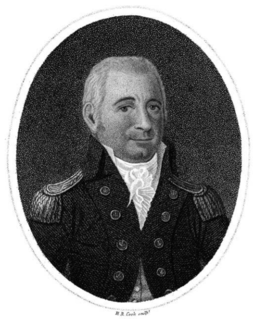
Captain Joseph Ellison was a Royal Navy officer. Having joined the service at the age of nine, he served during the Falklands Crisis in 1770 and went on to participate in the Battle of Bunker Hill and Siege of Pondicherry during the American Revolutionary War, during which he was promoted to lieutenant. On 4 July 1780 Ellison was serving on board HMS Prudente when they engaged, with another British frigate, two French frigates off Cape Ortegal. Ellison was badly wounded in the back during the battle and had an arm destroyed by a cannon ball that was amputated after the British had attained their victory. Having recuperated from his injuries Ellison was appointed to the impress service where he performed so well that he was promoted to commander in 1782 and post-captain in 1783. He took command of HMS Ariadne in April of that year and served in her off Ireland investigating fisheries, but in September he temporarily retired from the navy when his wounds began to become more problematic.

